The Day the Hemi Cuda Took Flight
Looking Back on Hemi Cuda Funny Car Development
By Moore Good Ink
Photos courtesy of Jim White
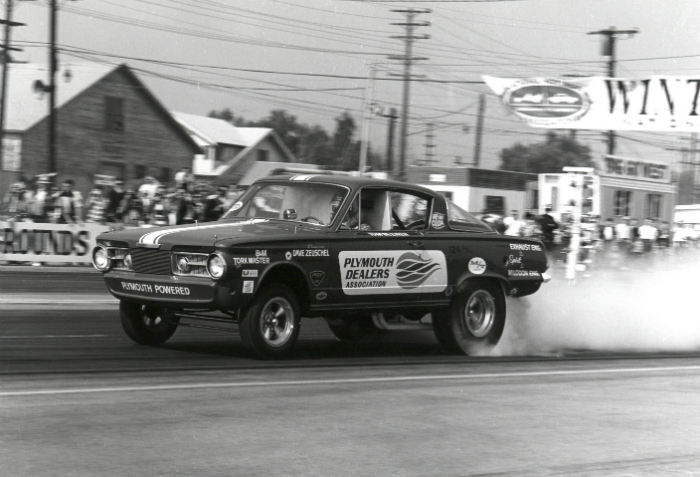
In 1965 Chrysler and the Southern Californian Plymouth Dealers Association underwrote the costs of constructing and operating a blown nitro 426cu in rear-engine Plymouth Hemi Barracuda Funny Car
Forty-eight years ago, toward the end of the 1965 drag racing season, Chrysler and their Southern Californian Plymouth Dealers Association underwrote the costs of constructing and operating a blown nitro 426cu in rear-engine Plymouth Hemi Barracuda Funny Car.
The proposition that brought together the Chrysler Corporation and the Southern Californian Plymouth Dealers Association was conceived by the late Lou Baney. Lou, who was already running the Mongoose in the Yeakel Plymouth Center’s Fuel dragster, could see the potential for exploiting a new Hemi Barracuda Funny Car in exhibitions and match races. The moment was right and the deal was struck and B&M Automotive were contracted to construct the car, Dave Zeuschel to prepare the engine and Tom “Mongoose” McEwen to drive it.
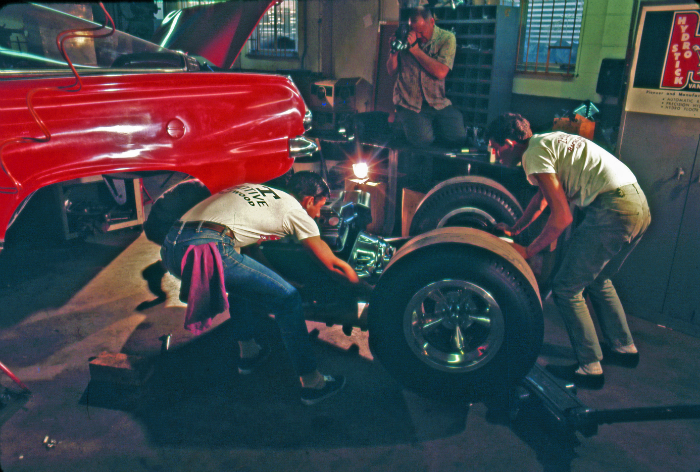
For 1965, the blown nitro 426ci engine and transaxle of the Plymouth Hemi Cuda funny car was moved to the rearweight transfer under acceleration, thus increasing the car’s traction
The origins of the Funny Car
The term Funny Car had derived from the appearance of Chrysler’s Ram Chargers a year earlier. The corporation’s competition department had moved the rear axle assembly forward on the chassis in an attempt to improve weight transfer under acceleration, thus increasing the car’s traction.
Also, funny by today’s standards, this fuel car, those that run on nitro methane, and others from that era exhibited a conspicuously high front ride height. Constructed with leaf springs resting on a simple front beam axle the high front ride height was most probably adopted for its ability to transfer weight quickly to the rear end during full acceleration. However, the practice came to an abrupt end when the “Mongoose” unleashed the new 1965 Barracuda on its first full quarter-mile run at Lions’ drag strip in Los Angeles.
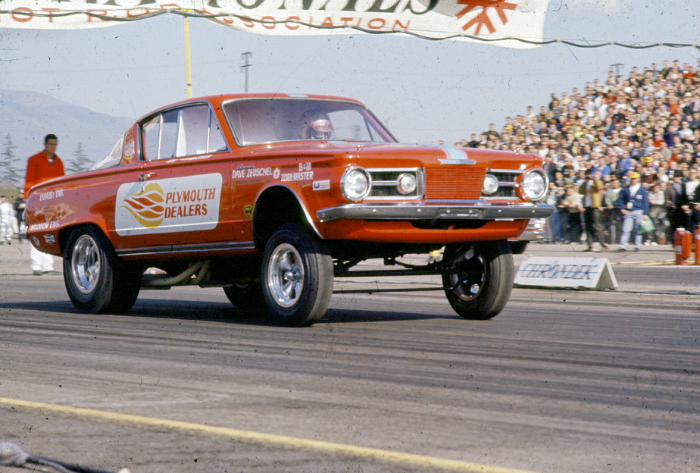
Constructed with leaf springs resting on a simple front beam axle the high front ride height was most probably adopted for its ability to transfer weight quickly to the rear end during full acceleration
Taking flight in the Barracuda
If it had occurred to anyone that the car’s contemporary body styling resembled that of an airplane wing and that at 160mph it might take flight, their comments were not recorded. But fly it did during a test session one fine autumn Sunday afternoon in 1965. Some reports cite the Barracuda climbed to 30 or 40ft before its parachute deployed, encouraging its return to mother earth.
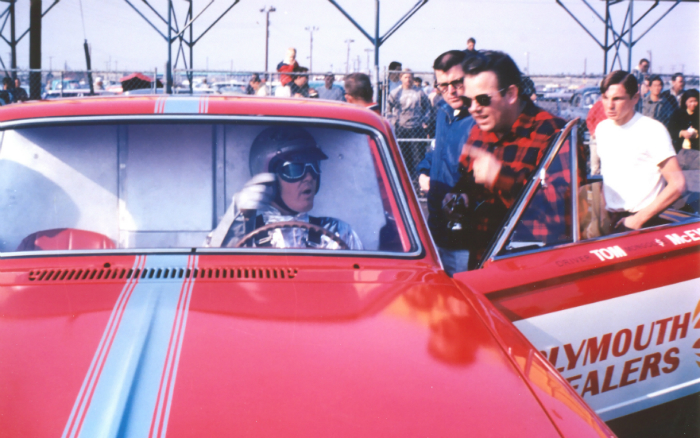
Mounting the Cuda’s engine and transmission in the rear created an unorthodox driving position, pushing “Mongoose” uncomfortably close to the steering wheel. Pictured from left: “Mongoose” McEwen, driver; the late Mickey Thompson (in blue), then manager of Lions Drag Strip; Dave Zeuschel (in red and black), engine builder; and Danny Thompson, Mickey’s son
Certainly Tom’s thoughts were not of aerodynamics. His mind was preoccupied by more pressing matters, chiefly the car’s unorthodox driving position. To allow space for the engine and transmission behind him, he had been pushed uncomfortably close to the steering wheel.
“About mid-track,” said Tom, “the car took flight and it seemed to climb a long way. I figured I was going to hit a pole or the fence or land on cars, but I pulled the parachute and switched off the motor and waited for the crash. Ironically the car glided down gently, landing on its side and then flipping onto its roof where it slid along the asphalt, setting the headliner on fire.”
Eventually the car reached track end where it somersaulted right way up, breaking all its wheels off. The driver’s door opened easily and the crew greeted the reluctant pilot. By Tom’s account, “They stood in amazement.”
Aftermath
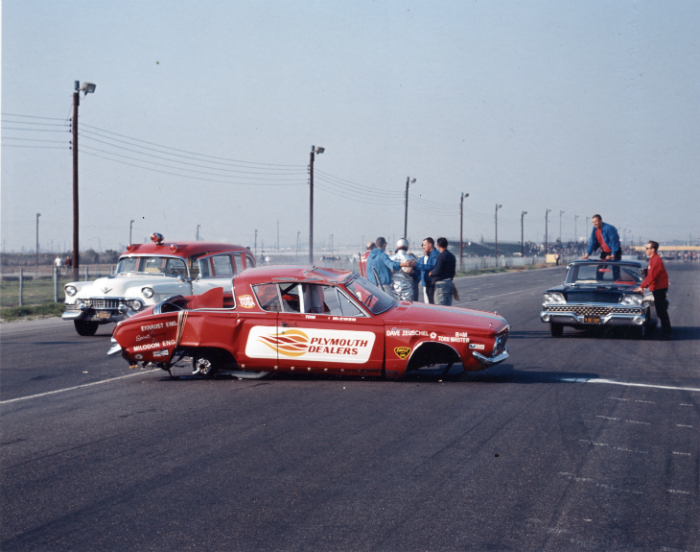
About mid-track the Cuda took flight then glided gently down landing on its side. It flipped onto its roof, setting the headliner on fire, and eventually reached track end where it somersaulted right way up, breaking all its wheels
The destroyed car was soon returned to B&M where they built another. Understandably Chrysler engineers decided to lower the car; install a front spoiler, though narrow by today’s standards it deterred full air flow from getting under the car; and fitting it with a short spoiler on the rear deck.
Thereafter the Barracuda proved to be a useful exhibition car, attracting much publicity not only with Mongoose but also later in the hands of Fred Goeske before it took residency in Don Garlits’ museum. Currently the car resides in Seattle where its present owner, Dana Winters, is engaged in a frame-off restoration.
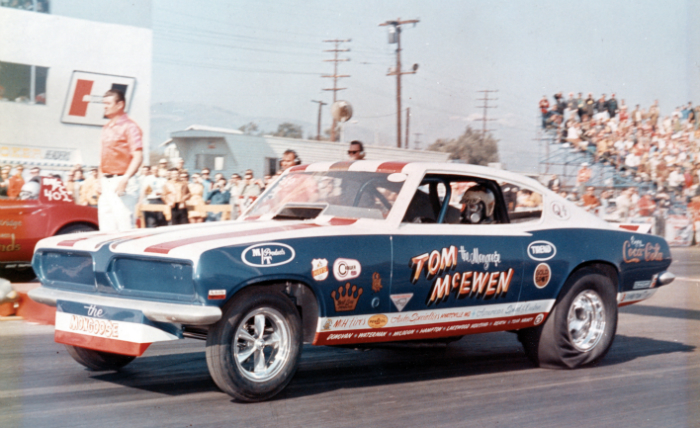
Later Chrysler engineers lowered the car; installed a narrow front spoiler that deterred full air flow getting under the car; and fitted it with a short spoiler on the rear deck
Although further aerodynamic concerns emerged five years later when Ronnie Scrima built two effective new chassis for the 1970 Hot Wheels Plymouths, it was the Corvettes of 1976 that caused most dismay. Of the six cars produced five of them crashed; only Tom McEwen’s survived.
“First, the Corvette had a short rear deck, which nullified the effect of the rear spoiler. At three-quarter track distance,” says Mongoose “the high-speed low-pressure air flowing over its roof generated so much lift at the rear the car became unstable, causing most of them to crash.”
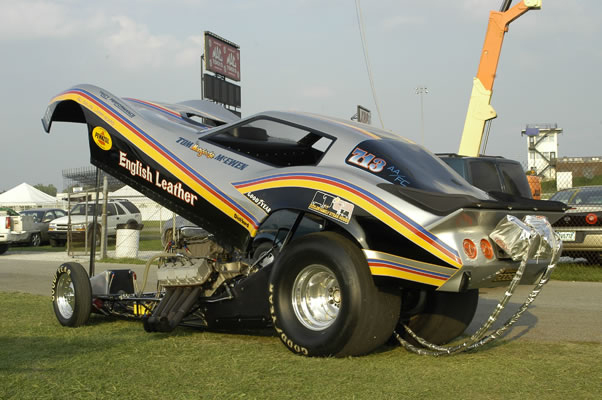
Subsequent consultations with an Indy 500 engineer pioneered the use of long end plates, so familiar on today’s Funny Cars. By lengthening the end plates and extending them further forward, they trapped air at the rear of the car, added down force to the rear wheels, and solved many aerodynamic troubles
Subsequent consultations with an Indy 500 engineer pioneered the use of long end plates, so familiar on today’s Funny Cars. These end plates, which are positioned at each end of the rear spoiler and extend forward, trapped air at the rear of the car, added down force to the rear wheels, and solved many aerodynamic troubles.
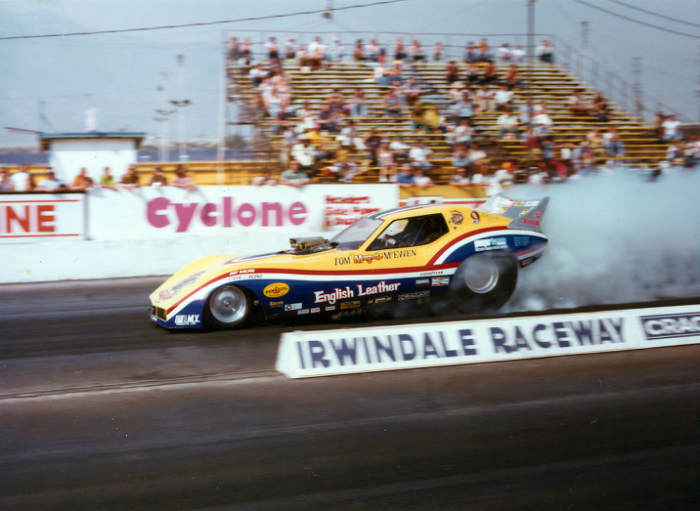
The Corvette had a short rear deck, which nullified the effect of the rear spoiler. At three-quarter track distance, the high-speed low-pressure air flowing over the roof generated so much lift at the rear they became unstable and most of them crashed
Those of us who have come to know the gentlemanly McEwen well are enraptured by his first-hand reminiscences of a time in drag racing that produced so many pioneers—a formative era in the sport that is worth revisiting. Next month the “Mongoose” talks about the developments that brought us the racing slick tires.







